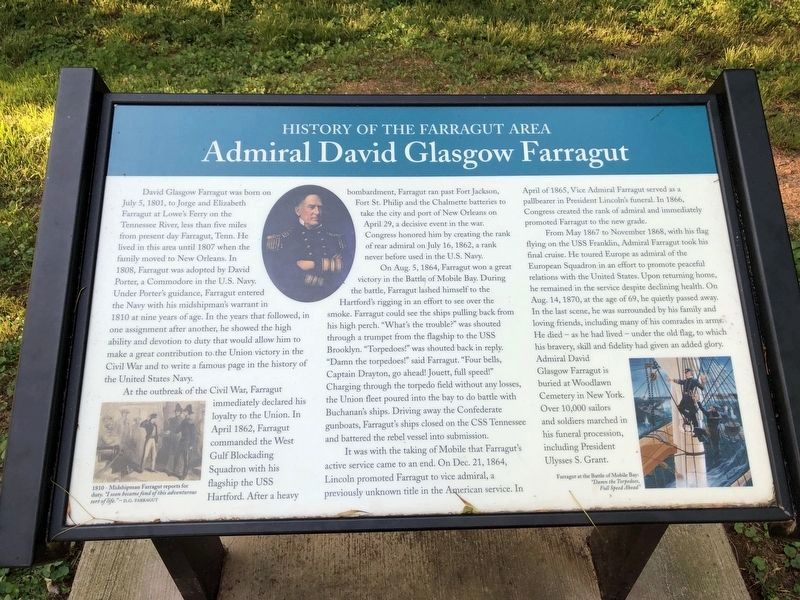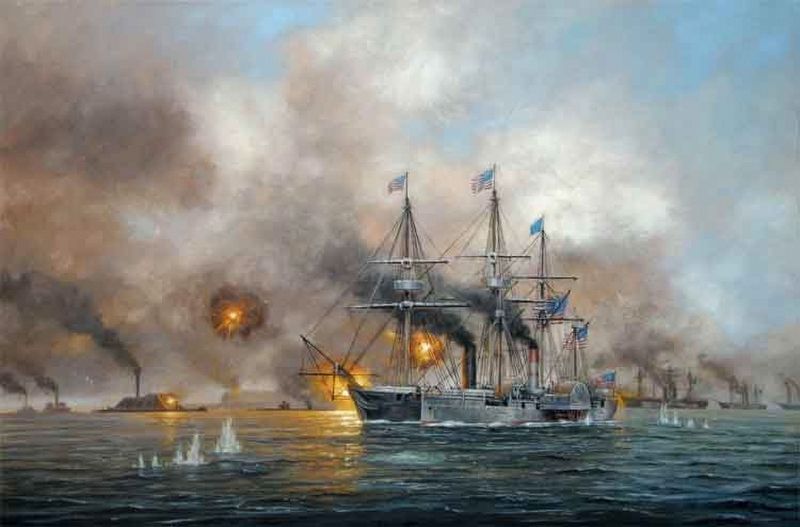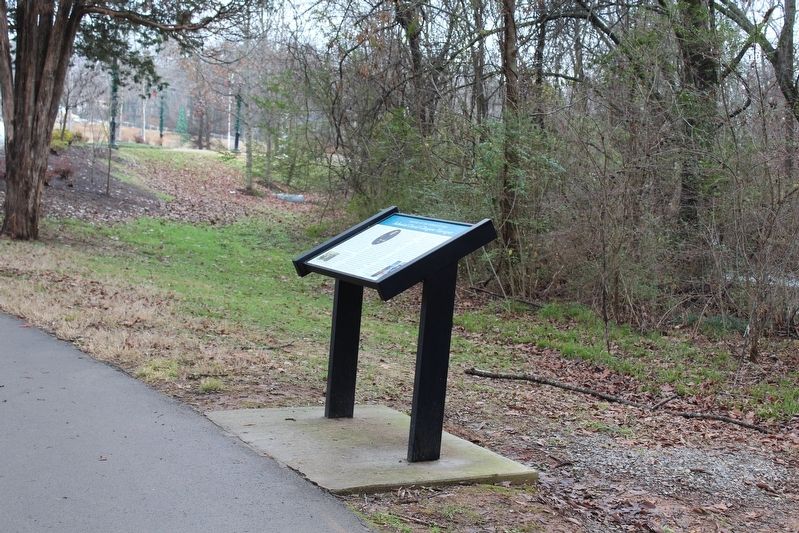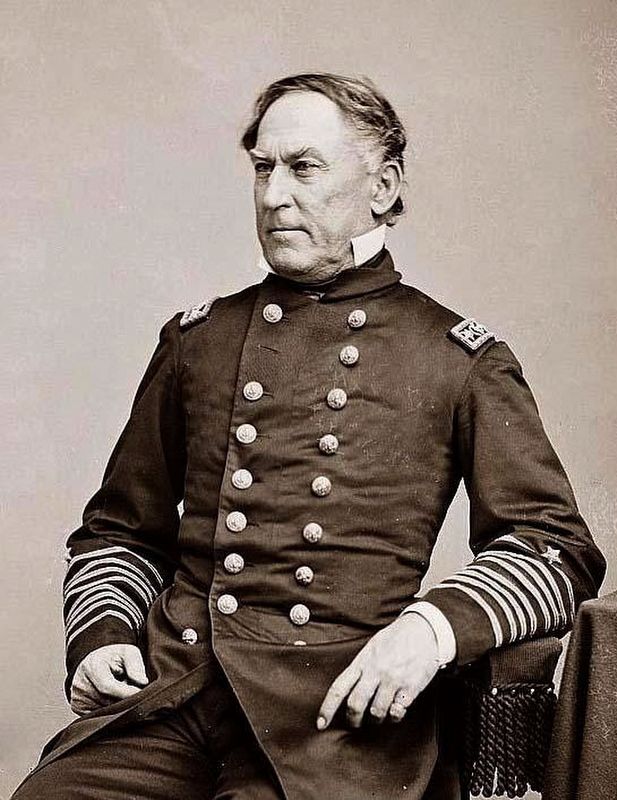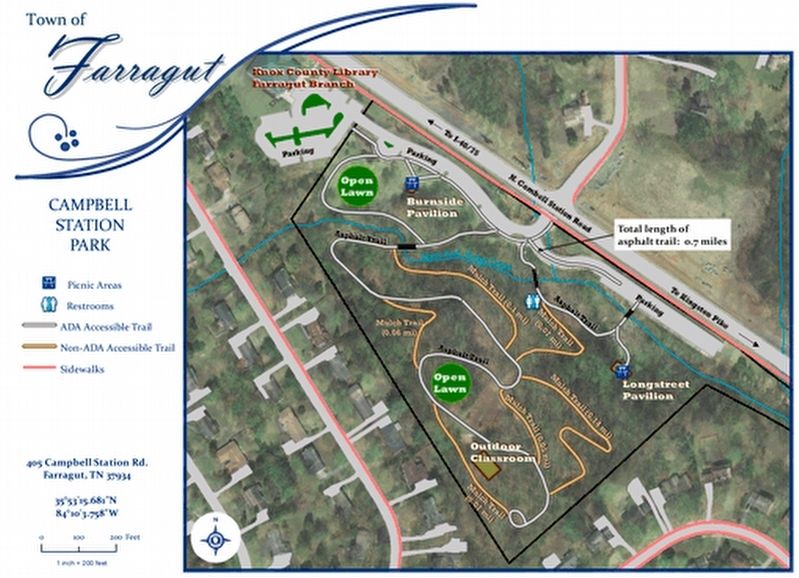Farragut in Knox County, Tennessee — The American South (East South Central)
Admiral David Glasgow Farragut
History of the Farragut Area
At the outbreak of the Civil War, Farragut immediately declared his loyalty to the Union. In April 1862, Farragut commanded the West Gulf Blockading Squadron with his flagship the USS Hartford. After a heavy bombardment, Farragut ran post Fort Jackson, Fort St. Philip and the Chalmette batteries to take the city and port of New Orleans on April 29, a decisive event in the war. Congress honored him by creating the rank of rear admiral on July 16, 1862, a rank never before used in the U.S. Navy.
On Aug. 5, 1864, Farragut won a great victory in the Battle of Mobile Bay. During the battle, Farragut lashed himself to the Hartford's rigging in an effort to see over the smoke. Farragut could see the ships pulling back from his high perch. "What's the trouble?" was shouted through a trumpet from the flagship to the USS Brooklyn. "Torpedoes!" was shouted back in reply. "Damn the torpedoes!" said Farragut. "Four bells, Captain Drayton, go ahead! Jouett, full speed!" Charging through the torpedo field without any losses, the Union fleet poured into the bay to do battle with Buchanan's ships. Driving away the Confederate gunboats, Farragut's ships closed on the CSS Tennessee and battered the rebel vessel into submission.
It was with the taking of Mobile that Farragut's active service came to an end. On Dec. 21, 1864, Lincoln promoted Farragut to vice admiral, a previously unknown title in the American service. In April 1865, Vice Admiral Farragut served as a pallbearer in President Lincoln's funeral. In 1866, Congress created the rank of admiral and immediately promoted Farragut to the new grade.
From May 1867 to November 1868, with his flag flying on the USS Franklin, Admiral Farragut took his final cruise. He toured Europe as admiral of the European Squadron in an effort to promote peaceful relations with the United States. Upon returning home, he remained in the service despite declining health. on Aug. 14, 1870, at the age of 69, he quietly passed away. In the last scene, he was surrounded by his family and loving friends, including many of his comrades in arms. he died — as he had lived — under the old flag, to which his bravery, skill and fidelity had given an added glory. Admiral David Glasgow Farragut is buried in Woodlawn Cemetery in New York. Over 10,000 sailors and soldiers marched in his funeral procession, including President Ulysses S. Grant.
Erected by Farragut Museum.
Topics and series. This historical marker is listed in these topic lists: Patriots & Patriotism • War, US Civil. In addition, it is included in the Former U.S. Presidents: #16 Abraham Lincoln, and the Tennessee - History of the Farragut Area series lists. A significant historical date for this entry is July 5, 1801.
Location. 35° 53.283′ N, 84° 10.083′ W. Marker is in Farragut, Tennessee, in Knox County. Marker can be reached from the intersection of North Campbell Station Road and Herron Road, on the left when traveling north. Marker is located on the walking trail in Campbell Station Park. Touch for map. Marker is at or near this postal address: 405 N Campbell Station Rd, Knoxville TN 37934, United States of America. Touch for directions.
Other nearby markers. At least 8 other markers are within walking distance of this marker. The Historic Village of Concord (within shouting distance of this marker); a different marker also named The Historic Village of Concord (within shouting distance of this marker); Pleasant Forest Church & Cemetery (about 300 feet away, measured in a direct line); The Battle of Campbell Station (about 300 feet away); Native American Settlement (about 300 feet away); The Campbell Station Inn (about 300 feet away); Farragut Schools: Early Years (about 500 feet away); Farragut Schools: Recent Years (about 600 feet away). Touch for a list and map of all markers in Farragut.
Credits. This page was last revised on March 16, 2022. It was originally submitted on January 16, 2017, by Tom Bosse of Jefferson City, Tennessee. This page has been viewed 771 times since then and 67 times this year. Photos: 1. submitted on March 16, 2022, by Pete Skillman of Townsend, Delaware. 2, 3, 4, 5. submitted on January 16, 2017, by Tom Bosse of Jefferson City, Tennessee. • Bernard Fisher was the editor who published this page.
